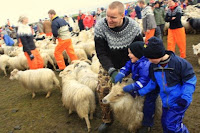 delicate economic state, along with the idea that it would be better for the industries to use green energy here, than to use coal powered electricity elsewhere.
delicate economic state, along with the idea that it would be better for the industries to use green energy here, than to use coal powered electricity elsewhere.
The day before the field trip, we had viewed a documentary entitled “Dreamland,” which is based off a book by Andri Snær Magnason. This wonderfully intense movie highlighted the ecological damages caused by the aluminum smelters who take advantage of the hydro power provided by one of Iceland’s rivers. One of the main points being made by this book/movie was that people tend to make irrational decisions when they’re afraid. In this case, Iceland’s government made an irrational decision by overlooking the damage done to Iceland’s ecosystems, and the importance of natural beauty to Iceland’s people. On the morning of the fieldtrip we had the rare privilege of meeting Andri and hearing him speak at the house of Halldór Laxness. In his talk, Andri shared with us that if all the aluminum in the United States that is thrown away was instead recycled, it would be enough to replace the entire US stock of airplanes, five times over. He followed this fact by asking us, when is what we produce considered enough?
 He made a convincing point that if a person has a large amount of something, he or she will just want more of it. It won’t compensate for future desires. He also stated that there are several other ways to enhance the Icelandic economy, including through the arts and tourism.
He made a convincing point that if a person has a large amount of something, he or she will just want more of it. It won’t compensate for future desires. He also stated that there are several other ways to enhance the Icelandic economy, including through the arts and tourism.The place where we met Andri was a museum that was once the house of the famou
 s Icelandic author Halldór Laxness. Now a historical museum, we received a tour of his house and learned of the impact he had on Icelandic literature. It was fascinating to see the array of books in various rooms!
s Icelandic author Halldór Laxness. Now a historical museum, we received a tour of his house and learned of the impact he had on Icelandic literature. It was fascinating to see the array of books in various rooms!After a brief stop at the Alfoss wool outlet, we headed for the main art museum in Reykjavik. The first gallery included several impressionists’ style paintings, but mostly we toured the gallery featuring the work of Jóhannes S. Kjarval.
Next we stopped at the sculpture museum, and former home, of Ásmundur Sveinsson. Working primarily with wood and stone, his themes included motherhood, childhood and growth, and heroism in Icelandic folklore. The most entertaining part of the museum was a dome-shaped room with incredible acoustics. If someone was whispering from across the room, it sounded like they were speaking directly into your ear!
Continuing on, we visited a sculpture park with more traditional art from Einar Jónsson. His metal sculptures depicted several stories and iterprutations of bilical stories and norse mythology. The park was directly outside of Hallgrímskirkja, a giant cathedral perched high on the hill in Reykjavik. Our final stop of the day included a tour inside of the church, along with a trip to the top of the main tower. From there we gazed down across the "smokey bay" taking in all the colorful buildings providing a contrast of color against the gray sky. Inspired by the day's array of creativity, the boys of the group paused for a moment to create a scuplture of their own. Their medium of cho
 ice: mustaches.
ice: mustaches.~Laurel
Photos: Laurel, Elizabeth-Anne, Meg

































